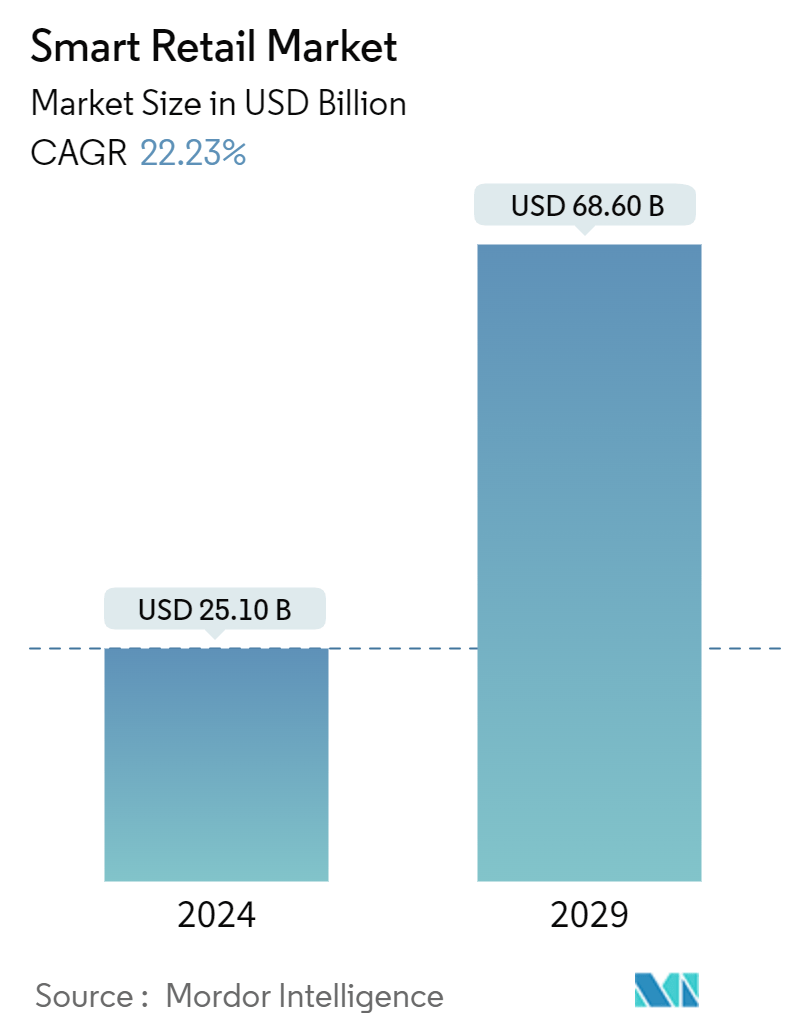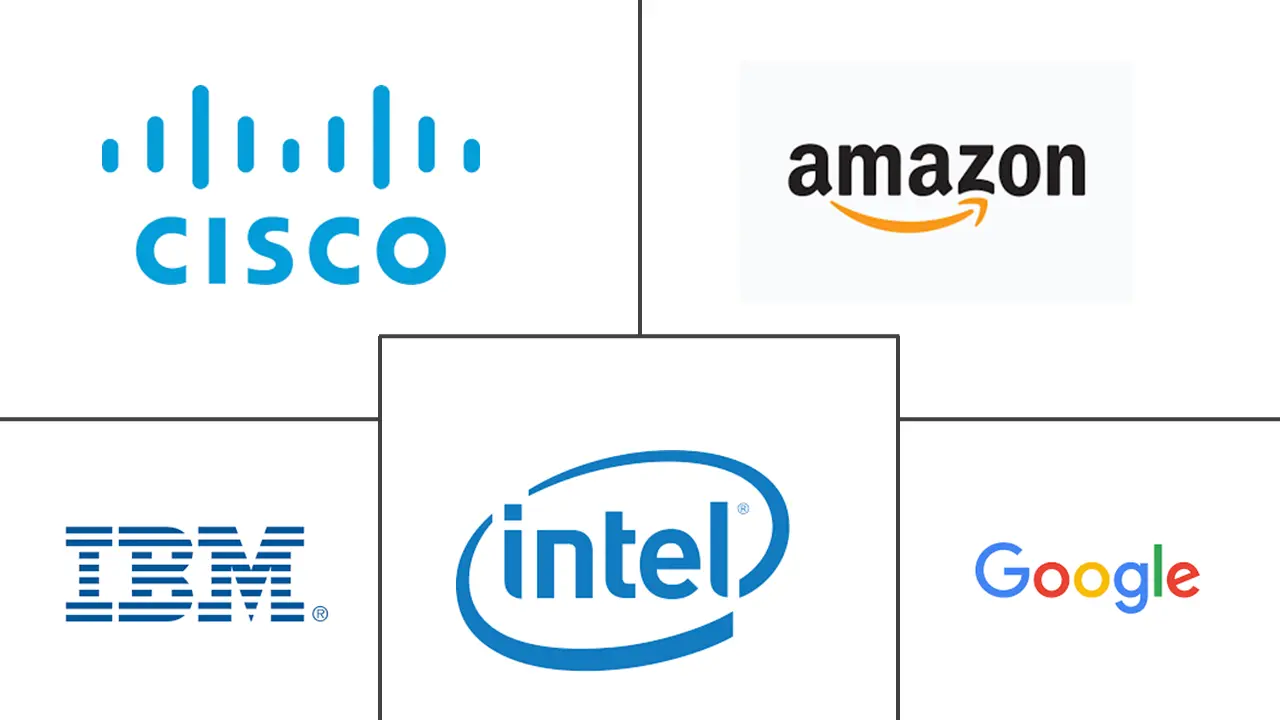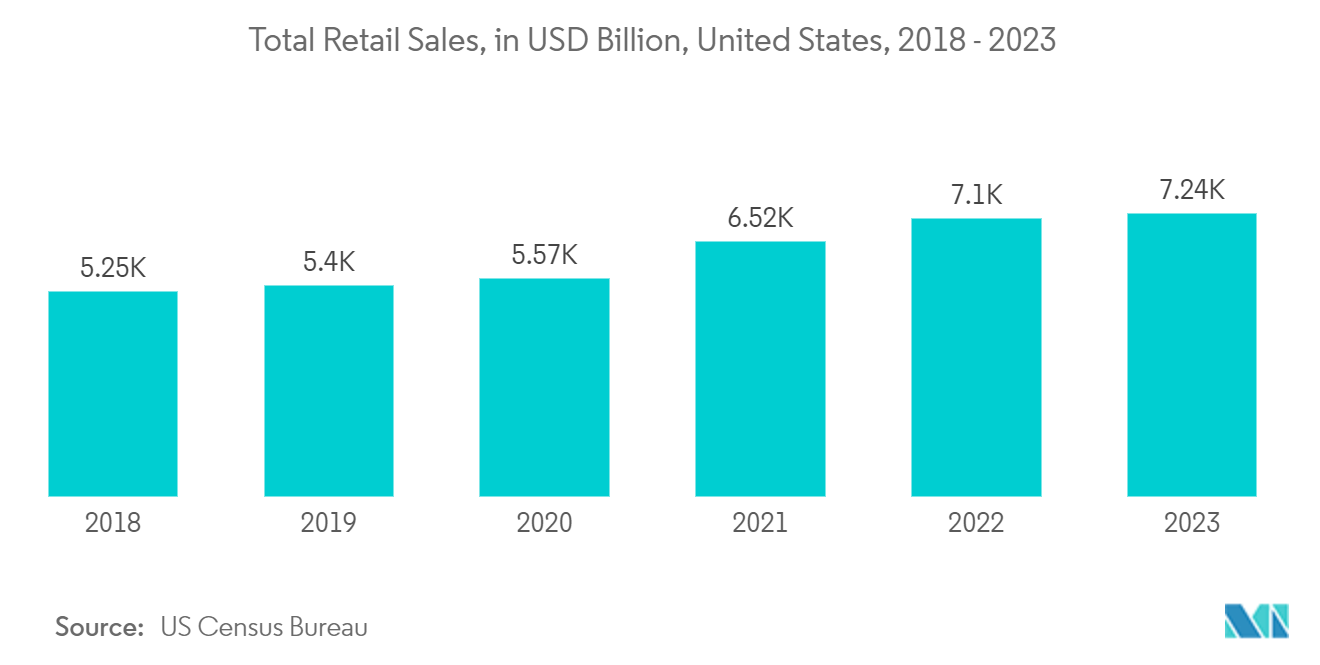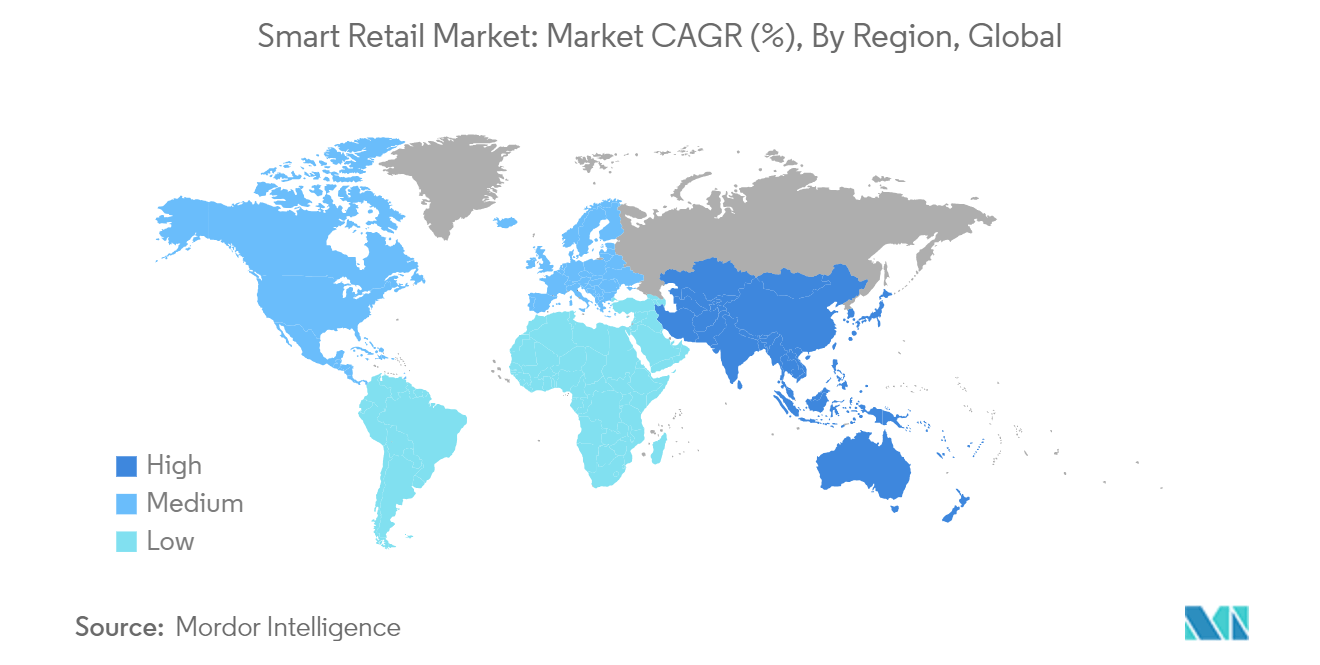Smart Retail Market Size

| Study Period | 2019 - 2029 |
| Market Size (2024) | USD 25.10 Billion |
| Market Size (2029) | USD 68.60 Billion |
| CAGR (2024 - 2029) | 22.23 % |
| Fastest Growing Market | North America |
| Largest Market | Asia Pacific |
Major Players
*Disclaimer: Major Players sorted in no particular order |
Smart Retail Market Analysis
The Smart Retail Market size is estimated at USD 25.10 billion in 2024, and is expected to reach USD 68.60 billion by 2029, growing at a CAGR of 22.23% during the forecast period (2024-2029).
- Smart retail encompasses the application of technology and data to improve the shopping experience for consumers while streamlining the operations of retailers. These innovative solutions empower businesses to elevate customer satisfaction, refine operational processes, and acquire significant insights into consumer behavior. The advancement of artificial intelligence profoundly influenced smart retail solutions. AI-driven technologies, including machine learning, computer vision, and natural language processing, enable retailers to process extensive datasets and derive insights regarding customer behavior and preferences. Such information can be utilized to tailor shopping experiences, enhance product recommendations, and streamline inventory management.
- In January 2024, Walmart revealed its intentions to explore artificial intelligence and drone technology further to enhance its customers' shopping experience. Among the advancements in artificial intelligence is the introduction of AI-driven generative search for iOS users, which recommends products tailored to consumers' inquiries, ranging from football gatherings to wedding celebrations.
- In the realm of smart retail, the Internet of Things (IoT) plays an important role by linking devices to the internet. This connection yields invaluable insights into consumer behavior, store operations, and inventory management. Retailers harness IoT devices, including sensors and beacons, to gather real-time data on inventory levels, consumer movement, and store assets. Such data help retailers to make informed decisions and streamline their processes.
- The retail sector is deeply connected to individuals' everyday experiences. Business proprietors must remain informed about changing consumer preferences while also addressing various operational hurdles. These hurdles encompass inventory management, customer foot traffic, marketing approaches, and expense control. As a result, the retail industry's digital transformation and intelligent enhancement are both experiencing significant growth.
- Many retailers lack the infrastructure and network components to handle the substantial volumes of IoT data. For merchants to successfully digitize their retail environments, it is essential to implement a strong network, cloud-based solutions, and end-user devices such as barcode scanners, tablets, and mobile point-of-sale systems. Acquiring these elements would necessitate a substantial financial investment, making it difficult for small and medium retail stores to adopt these technologies quickly.
- Macroeconomic factors, such as fluctuations in exchange rates and shifts in international trade dynamics, could sway the global smart retail market. Changes in currency values might influence the costs of imported smart retail hardware and raw materials, subsequently impacting equipment manufacturers' pricing strategies and profitability. Hence, such factors also influence the studied market's growth.
Smart Retail Market Trends
Inventory Managment Segment is Expected to Hold Significant Market Share
- Conventional inventory management techniques present numerous difficulties, including excessive or insufficient stock and tedious manual product monitoring. These challenges deplete resources and hinder retailers' ability to compete effectively in a rapidly changing market.
- Integrating IoT technology can effectively mitigate these issues by enhancing inventory visibility. Retailers can optimize their procurement strategies by adopting smart inventory management systems that utilize store shelf sensors, RFID tags, beacons, video surveillance, and digital price tags. When inventory falls below a certain threshold, the system recommends reordering the appropriate quantity based on insights derived from IoT data analytics.
- By utilizing smart inventory management systems, retailers can gain a comprehensive, real-time inventory perspective. This technological advancement reduces the likelihood of human error. It provides decision-makers with precise and current information, allowing for prompt responses to fluctuations in demand or disruptions within the supply chain. Integrating technologies such as wireless Radio Frequency Identification (RFID) facilitates the automation and optimization of inventory tracking, thereby minimizing human error and guaranteeing timely updates.
- Artificial intelligence is essential in managing inventory in the retail industry, as it enhances stock levels, lowers expenses, and increases operational efficiency. AI-driven algorithms evaluate past sales data, prevailing market trends, and various other elements to accurately predict demand. This capability enables retailers to establish the ideal inventory levels for each item, reducing the risks of overstocking and stock shortages.
- The growing retail industry worldwide is anticipated to increase the number of retail stores, creating a favorable ecosystem for the studied segment's growth. For instance, according to the US Census Bureau, by the conclusion of 2023, total retail sales amounted to roughly USD 7.24 trillion, reflecting an increase of approximately USD 1.5 billion compared to the previous year.

Asia Pacific is Expected to Hold Significant Market Share
- The notion of 'smart retail' is transforming consumer experiences across Asia-Pacific, significantly influenced by the region's swift urbanization and digital advancements. As the demographic shift progresses from rural to urban areas, new logistical challenges have emerged, which 'smart retail' aims to tackle in response to the evolving needs of consumers in the APAC region. This innovative retail framework extends beyond shopping, incorporating consumer services such as finance, transportation, and entertainment.
- India, Japan, and China have emerged as dynamic centers for startups, presenting numerous opportunities for growth and innovation within their flourishing ecosystems. As reported by IBEF, India is experiencing significant retail expansion, further driving the growth of the market studied.
- From April 2000 to June 2023, India's retail trading sector attracted foreign direct investment (FDI) amounting to USD 4.48 billion, positioning it as the fifth largest globally and contributing approximately 10% to the nation's GDP. These elements have elevated the Indian startup culture to unprecedented levels, with various factors playing a role in its swift advancement. Notably, the government's ongoing support through initiatives like the 'Startup India' campaign and establishing favorable policies fosters a conducive environment for startups, driving opportunities in the market studied.
- The increasing utilization of advanced retail technologies, including big data analytics, smart fitting mirrors, reception robots, and shopping assistance robots in nations like Japan and China, is anticipated to propel market expansion in the region. In addition to major smart retail companies such as Alibaba and Amazon, smaller enterprises are also seeking to seize this opportunity.
- The expanding retail sector in Japan is bolstering market growth. As reported by METI, Japan's retail sales experienced a year-on-year uptick of 5.3% in November 2023. This marked the first acceleration in three months, following a revised 4.1% gain in October. Notably, this growth outpaced market predictions, which had forecasted a 5% rise. In 2022, the Japanese retail sector boasted sales nearing JPY 154.4 trillion (USD 1.07 trillion).
- Market players are rolling out innovative solutions to cater to rising demands, fueling regional market growth. For instance, in August 2024, ZKONG Networks was poised to make a significant impact at the upcoming China in-store 2024—Shanghai International Store Design and Solutions Exhibition. At this event, ZKONG Networks was expected to unveil its latest digital store solution to help global retailers achieve intelligent and scalable store management.

Smart Retail Industry Overview
The smart retail market is fragmented and consists of various players. Market players adopt various strategies such as strategic mergers and acquisitions, product innovation, and market expansion to stay ahead of the competition. Some key players include Google LLC, Intel Corporation, Amazon.com, Inc., IBM Corporation, Cisco Systems, Inc., and others. Some of the recent developments in the market include:
• May 2024: Wipro Limited announced enhancing its retail-oriented capabilities within Wipro VisionEDGE+. This upgraded solution, created in collaboration with Cisco and AT&T and utilizing Amazon Web Services (AWS), functions as a holistic retail transformation platform to maximize the potential of retail media networks.
• April 2024: Fiserv, Inc. revealed improvements to its Pix hub technology. This technology, which is presently accessible to businesses in Brazil, aims to expedite the acceptance of electronic person-to-business payments through an agnostic platform, enabling retailers to select their preferred Payment Service Providers (PSPs). The enhancements include features such as unified management, high availability, and advanced security measures, including monitoring and fraud prevention, to reduce business risks. Additionally, Fiserv is offering merchants the choice to process Pix payments either through Fiserv or their selected PSPs.
Smart Retail Market Leaders
-
Google LLC
-
Intel Corporation
-
IBM Corporation
-
Cisco Systems, Inc.
-
Amazon.com, Inc.
*Disclaimer: Major Players sorted in no particular order

Smart Retail Market News
- June 2024: Instacart, in collaboration with Price Chopper and McKeever's Market & Eatery, announced the introduction of Caper Carts, which are powered by artificial intelligence, at select locations in Missouri. These innovative smart carts enhance the shopping experience by enabling customers to scan items while they shop easily, monitor their grocery budget in real time, and bypass the checkout line altogether.
- February 2024: Huawei introduced the Smart Retail Solution, tailored for retail campuses, individual stores, and interconnected multi-branch operations. This series of solutions emphasizes smart retail environments, intelligent warehousing, energy efficiency, and digital marketing strategies. By leveraging cutting-edge Wi-Fi, storage, cloud, and Internet of Things (IoT) technologies, it aims to enhance operational efficiency, lower expenses, and elevate the consumer experience for retail enterprises.
Smart Retail Market Report - Table of Contents
1. INTRODUCTION
- 1.1 Study Assumptions and Market Definition
- 1.2 Scope of the Study
2. RESEARCH METHODOLOGY
3. EXECUTIVE SUMMARY
4. MARKET INSIGHTS
- 4.1 Market Overview
-
4.2 Industry Attractiveness - Porter's Five Forces Analysis
- 4.2.1 Bargaining Power of Suppliers
- 4.2.2 Bargaining Power of Consumers
- 4.2.3 Threat of New Entrants
- 4.2.4 Threat of Substitute Products
- 4.2.5 Intensity of Competitive Rivalry
- 4.3 Industry Value Chain Analysis
- 4.4 Impact of COVID-19 Aftereffects and Other Macroeconomic Factors on the Market
5. MARKET DYNAMICS
-
5.1 Market Drivers
- 5.1.1 Growing Investments in Retail Chains and Retail Supermarkets
- 5.1.2 Rising Adoption of Advances in Technology Across Retail Chain
-
5.2 Market Challenges
- 5.2.1 Lack of Infrastructure Will Hinder the Market Growth
- 5.2.2 Data Security and Privacy Concerns
6. MARKET SEGMENTATION
-
6.1 By Component
- 6.1.1 Hardware
- 6.1.2 Software
- 6.1.3 Services
-
6.2 By Application
- 6.2.1 Inventory Management
- 6.2.2 Brand Protection
- 6.2.3 Foot-Traffic Monitoring
- 6.2.4 Loyalty Management and Payment
- 6.2.5 Predictive Equipment Maintenance
- 6.2.6 Others
-
6.3 By Geography***
- 6.3.1 North America
- 6.3.2 Europe
- 6.3.3 Asia
- 6.3.4 Australia and New Zealand
- 6.3.5 Latin America
- 6.3.6 Middle East and Africa
7. COMPETITIVE LANDSCAPE
-
7.1 Company Profiles
- 7.1.1 Google LLC
- 7.1.2 PAX Global Technology Limited
- 7.1.3 Intel Corporation
- 7.1.4 Verifone Systems
- 7.1.5 Cisco Systems, Inc.
- 7.1.6 Huawei Technologies Co., Ltd.
- 7.1.7 IBM Corporation
- 7.1.8 Fiserv, Inc.
- 7.1.9 Microsoft
- 7.1.10 Honeywell International Inc.
- 7.1.11 NVIDIA Corporation
- 7.1.12 Samsung Electronics
- 7.1.13 Amazon.com, Inc.
- 7.1.14 NXP Semiconductors
- 7.1.15 Caper Inc.
- 7.1.16 Ingenico Group
- 7.1.17 Focal Systems, Inc.
- 7.1.18 LG Display Co, Ltd.
- 7.1.19 NCR Corporation
- *List Not Exhaustive
8. INVESTMENT ANALYSIS
9. FUTURE OUTLOOK OF THE MARKET
** Subject To AvailablitySmart Retail Industry Segmentation
The study tracks the revenue accrued through selling smart retail hardware, software, and services by various players in the global market. The study also tracks the key market parameters, underlying growth influencers, and major vendors operating in the industry, which supports the market estimations and growth rates over the forecast period. The study further analyses the overall impact of COVID-19 aftereffects and other macroeconomic factors on the market. The report’s scope encompasses market sizing and forecasts for the various market segments.
The smart retail market is segmented by component (hardware, software, and services), by application (inventory management, brand protection, foot traffic, loyalty management and payment, predictive equipment maintenance, and others), and by geography (North America, Europe, Asia-Pacific, Latin America, and Middle East & Africa). The market sizes and forecasts are provided in terms of value (USD) for all the above segments.
| By Component | Hardware |
| Software | |
| Services | |
| By Application | Inventory Management |
| Brand Protection | |
| Foot-Traffic Monitoring | |
| Loyalty Management and Payment | |
| Predictive Equipment Maintenance | |
| Others | |
| By Geography*** | North America |
| Europe | |
| Asia | |
| Australia and New Zealand | |
| Latin America | |
| Middle East and Africa |
Smart Retail Market Research FAQs
How big is the Smart Retail Market?
The Smart Retail Market size is expected to reach USD 25.10 billion in 2024 and grow at a CAGR of 22.23% to reach USD 68.60 billion by 2029.
What is the current Smart Retail Market size?
In 2024, the Smart Retail Market size is expected to reach USD 25.10 billion.
Who are the key players in Smart Retail Market?
Google LLC, Intel Corporation, IBM Corporation, Cisco Systems, Inc. and Amazon.com, Inc. are the major companies operating in the Smart Retail Market.
Which is the fastest growing region in Smart Retail Market?
North America is estimated to grow at the highest CAGR over the forecast period (2024-2029).
Which region has the biggest share in Smart Retail Market?
In 2024, the Asia Pacific accounts for the largest market share in Smart Retail Market.
What years does this Smart Retail Market cover, and what was the market size in 2023?
In 2023, the Smart Retail Market size was estimated at USD 19.52 billion. The report covers the Smart Retail Market historical market size for years: 2019, 2020, 2021, 2022 and 2023. The report also forecasts the Smart Retail Market size for years: 2024, 2025, 2026, 2027, 2028 and 2029.
Smart Retail Industry Report
Statistics for the 2024 Smart Retail market share, size and revenue growth rate, created by Mordor Intelligence™ Industry Reports. Smart Retail analysis includes a market forecast outlook for 2024 to 2029 and historical overview. Get a sample of this industry analysis as a free report PDF download.



